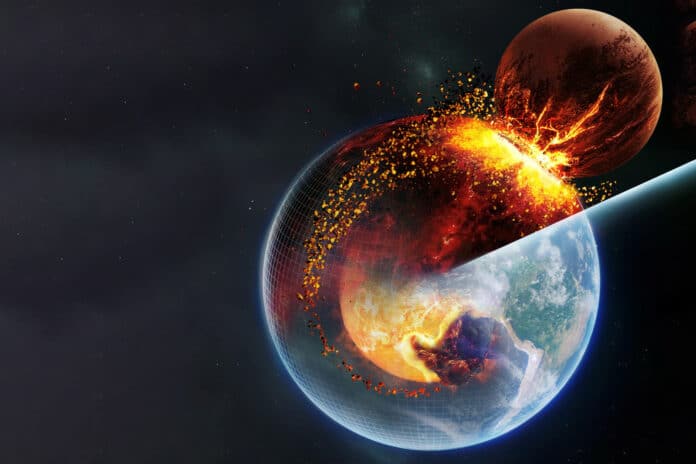For several generations, astronomers have been baffled by the mystery surrounding the Moon’s formation. The prevailing idea states that a catastrophic collision, referred to as the “giant impact,” took place between primordial Earth (Gaia) and a proto-planet called Theia that was around the size of Mars during the late stages of Earth’s evolution around 4.5 billion years ago. It is thought that the debris from this impact produced the Moon.
Although several improved models of the massive impact have since been put forth, they have all encountered difficulties.
In 2017, Prof. DENG Hongping of the Shanghai Astronomical Observatory (SHAO) of the Chinese Academy of Sciences started studying the Moon’s formation to improve the hypothesis of lunar formation. His work focused on creating Meshless Finite Mass (MFM), a novel approach to computational fluid dynamics that excels at precisely simulating turbulence and material mixing.
Using this novel approach and conducting numerous simulations of the giant impact, an interdisciplinary, international research team has recently discovered that a massive anomaly deep within the Earth’s interior may be a remnant of the collision about 4.5 billion years ago that formed the Moon. The study gives new insights into Earth’s internal structure, its long-term evolution, and the formation of the inner solar system.
Using this method, scientists found that following the impact, the upper and lower mantles of the early Earth showed signs of stratification, with varying compositions and states. To be more precise, the lower mantle stayed mostly solid and preserved the material composition of Gaia. At the same time, the higher cover contained a magma ocean formed by thoroughly mixing material from both Gaia and Theia.
Prof. DENG and collaborators discovered that this mantle stratification may have continued to the present day after speaking with geophysicists from the Swiss Federal Institute of Technology in Zurich. This corresponds to the global seismic reflectors in the mid-mantle, which are about 1000 km below the surface of the Earth. In particular, according to Prof. DENG’s earlier research, the entire Earth’s lower mantle may still be dominated by pre-impact Gaian material, which differs from the upper mantle regarding elemental composition (including having a higher silicon content).
Prof. DENG said, “Our findings challenge the traditional notion that the giant impact led to the homogenization of the early Earth. Instead, the Moon-forming giant impact appears to be the origin of the early mantle’s heterogeneity and marks the starting point for the Earth’s geological evolution over 4.5 billion years.”
Two peculiar regions called Low-Velocity Provinces (LLVPs) are another example of Earth’s mantle heterogeneity. These regions are spread across thousands of kilometers at the base of the mantle. One is beneath the tectonic plates of Africa, while the other is situated beneath the Pacific. Seismic waves travel at a considerably slower speed in these regions.
The tectonic plate systems of Earth, the mantle’s evolution, and the division and aggregation of supercontinents are all significantly impacted by LLVPs. But their beginnings are still unknown.
A little amount of Theian material that penetrated Gaia’s lower mantle may have given rise to LLVPs, according to a theory by Dr. YUAN Qian of the California Institute of Technology and coworkers.
Prof. DENG was then invited to investigate the distribution and condition of Theian material in the deep Earth following the massive impact.
By performing new, higher-precision simulations and thoroughly reviewing earlier giant-impact models, the study team discovered that a sizable portion of Theian mantle material—roughly two percent of Earth’s mass—entered Gaia’s lower mantle.
The traditional Smoothed Particle Hydrodynamics (SPH) methods were used to confirm the conclusion. Scientists also determined that this Theian mantle material, like lunar rocks, is enriched with iron, making it denser than the surrounding Gaian material.
That’s why it rapidly sank to the bottom of the mantle and, throughout long-term mantle convection, formed two prominent LLVP regions. These LLVPs have remained stable throughout 4.5 billion years of geological evolution.
Whether in the LLVPs at the base or the mid-mantle reflectors, heterogeneity in the deep mantle indicates that the Earth’s interior is anything but a homogeneous and “boring” system. In reality, mantle plumes—cylindrical upwelling thermal currents transported to the surface by mantle convection—like those that most likely generated Iceland and Hawaii—can bring modest amounts of deep-seated heterogeneity to the surface.
Dr. YUAN states, “Through precise analysis of a wider range of rock samples, combined with more refined giant impact models and Earth evolution models, we can infer the material composition and orbital dynamics of the primordial Earth, Gaia, and Theia. This allows us to constrain the entire history of the formation of the inner solar system.”
Prof. DENG sees an even broader role for the current study: “This research even inspires understanding the formation and habitability of exoplanets beyond our solar system.”
Journal Reference:
- Yuan, Q., Li, M., Desch, S.J. et al. Moon-forming impactor as a source of Earth’s basal mantle anomalies. Nature 623, 95–99 (2023). DOI: 10.1038/s41586-023-06589-1
